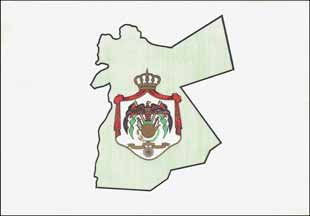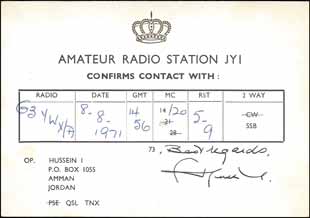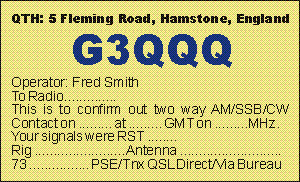What is a QSL Card: Ham QSL Cards
QSL cards have been exchanged by radio amateurs since the beginning of the hobby to confirm contacts. Find out more about these ham radio QSL cards.
QSL cards includes:
QSL cards
Electronic QSLs
QSL bureau
QSL managers
Vintage QSL gallery
QSL cards are widely exchanged between ham radio operators to confirm contacts between two radio stations or to acknowledge short wave listener reports.
These cards are often said to be the final courtesy of a contact, and indeed many millions of QSL cards are exchanged each year.
Whilst QSL cards can provide a proof for operating awards of a contact with a particular country or area, they are also interesting to collect as they will have come from many people, often from distant lands or islands where few people live.
What is a QSL card?
The term QSL comes from the radio "Q" code meaning "I confirm reception", and purpose of a QSL card is to confirm a contact. The cards themselves are normally post card sized, many being colourful and very attractive. Quite a few have photographs of the ham radio station, the operator or the area in which he lives, and this makes them very interesting.
The idea for the QSL card dates back to the time when the first long distance amateur radio or ham radio contacts were being made on the short wave bands. Initially the ham radio stations exchanged letters to confirm a contact, but the idea for a pre-printed card soon arose. It is not certain which was the first QSL card, or the first station to use them, but the idea soon caught on.
Today ham radio operators send QSL cards for a variety of reasons. It is interesting to collect them. Having made contact with a particular ham radio station it is often nice to have a card from them to remember the contact. It may be a particularly interesting contact, or one with a rare country where few ham radio operators are active. It may even be with a famous personality as there are a number of famous people around the globe who hold amateur radio licenses. In addition to this the cards can displayed in the radio shack. Being colourful and interesting they can brighten up any ham radio shack.


The front and back of a QSL card from King Husssein of Jordan, JY1
Cards are also required when applying for some ham radio awards. One of the most famous awards is DXCC (DX Century Club). It is issued by the American Radio Relay League for submitting proof of making contacts with a hundred countries. Endorsements can be issued for making contacts with further countries. Naturally QSL cards are normally used as proof of making the contacts.
QSL card content
A QSL card should contain sufficient information to confirm a ham radio contact. Normally the card is pre-printed with the call sign of the originating ham radio station placed prominently on it. In addition to this the ham radio QSL card should have a number of other details. These include:
- Operator's name and address: This is obviously very important as it states where the station is located and who is operating the station. Some items associated with the location may be required on some occasions:
- QRA locator: This is important for many people operating on the VHF and UHF bands.
- Island: For people located on an island, this can also be important as many operators work towards awards where they have to contact people on different islands.
- Callsign of station being contacted:
- Date: This is an obvious requirement for any QSL card, and care should be taken in ensuring this is filled in correctly.
- Time : The time is included on the QSL cards and is normally given in GMT - Greenwich Mean Time or UTC - Universal Time Coordinated. These are exactly the same and by using one standard globally there is no need for time zone conversions. Sometimes the letter 'z' may be used to denote UTC / GMT.
- Signal report : The signal report given is useful because it confirms the signal strength, readability and other factors related to the conditions at the time.
- Frequency / band: The band, or preferably the frequency of the contact should be included.
- Mode of operation : The mode of operation is important. Some DX stations may run several stations at the same time, and therefore the mode of operation is important. It is also important when claiming awards as it may be necessary to detail the mode for the award.
- Equipment used: It is always interesting to see what toher stations use. It also help determine how your own station is working out if it is possible to see reports and also the equipment used by the other station.
- Pse / Tnx QSL: It is helpful to have space to say whether a card has been received, or whether one is wanted from the other station. Something like "PSE/TNX QSL" (please / thanks QSL) is often used.

Format of a basic QSL card
Who uses QSL cards?
Many people send QSL cards. Although they are not nearly as widely used, they are still useful and also attractive to collect;
- Radio amateurs: Many transmitting ham radio operators, particularly those using the HF bands send them regularly. The practise is less common for contacts above 30 MHz, although for DX contacts many stations still need to collect QSL cards for awards.
- Short wave listeners: Listeners often send QSL cards as well. They may send a card to a transmitting station to give a listener report in the hope of receiving a card back. However many DX stations receive vast numbers of listener reports that are of little use. Many say little more than "I heard you please QSL". If a report is to stand a good chance of receiving a reply and a return QSL card then it should give some useful information. Band conditions, whether any other stations from the same area were heard, or any significant characteristics of the signal.
- Broadcast stations: Occasionally other stations may send QSL cards. Often short wave broadcast stations may send them to listeners who send in good reports. To qualify for a QSL card, broadcast stations often require that the listener has listened to the station over a period of time. However as budgets for HF broadcast stations are being cut, QSL cards are becoming more difficult to obtain.
Collecting QSL Cards
Collecting QSL cards can be an interesting addition to the hobby of amateur radio. Cards from distant corners of the earth can be attractive and interesting. Not only do they brighten up the shack, but they can act as an encouragement to hear or contact some more interesting stations as well as being used to apply for operating awards.
More Ham Radio Topics:
What is ham radio
Callsigns
Morse code
Voice modes
Digital data modes
QRP operating
Operating awards
Codes & abbreviations
Ham bands overview
Operating via differnet propagation modes
Repeaters
Callsigns
Contact formats
Setting up a shack & buying equipment
Return to Ham radio menu . . .



